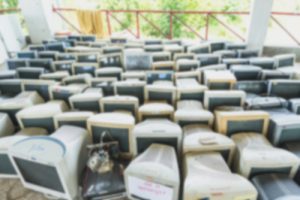
That determination was approved by the board of Sustainable Electronics Recycling International (SERI), the nonprofit organization that administers the R2 standard. R2 is an environmental, worker health and safety standard for the electronics refurbishing and recycling industry.
Nearly 650 facilities around the world currently have R2 certification.
SERI’s board in January approved a “formal interpretation” of what was potentially unclear language in the current version of the standard, R2:2013. It was the first formal interpretation of language in R2:2013.
The formal interpretation went into effect Feb. 1.
What they decided
The unclear language was in a section discussing facilities’ obligations when handling “focus materials,” which include PCBs, mercury, CRT components, batteries and circuit boards. The section requires R2-certified facilities to, among other things, safely process focus materials (FMs) and conduct due diligence on the downstream vendors they’re shipping FMs to.
The language in that section says the requirement apply to an R2-certified company when the FMs “pass through its facility or control.” The question was: What does “control” mean in this context?
SERI decided it means anytime a company takes physical possession or ownership of the scrap electronics, even if the material never enters the building connected to the certification. That means the requirements would apply when an e-scrap company is aggregating material off site (regardless of whether it is directly running or contracting with a third party to run the aggregation site). It also applies when a contracted third-party is picking up equipment on behalf of the R2-certified facility.
The formal interpretation aims to provide clarity to both R2 companies and the certification bodies auditing them, said Corey Dehmey, R2 director at SERI.
“Auditors can now definitively write a nonconformance for something that happens outside of those four walls that’s connected to the R2-certified facility,” he said.
Applies to broker situations
Dehmey described situations in which the FM requirements would apply.
For example, if an e-scrap company is aggregating material at a site and its downstream vendor is closer to that site than the company’s main processing facility is, then it may be more efficient to ship directly to the downstream vendor. The formal interpretation makes clear the FM requirements still apply to those electronics.
Another situation is when a company buys circuit boards from a broker and sends them downstream for metals recovery without bringing them back to the R2-certified facility.
“That brokering transaction needs to happen in accordance with their certification,” Dehmey said.
The formal interpretation does not necessarily mean auditors will go off site to inspect the handling of material, but it makes clear that they have that authority to if the audit trail leads off-site and they suspect there’s a nonconformance.
The formal interpretation process was kickstarted by SERI’s Technical Advisory Committee, which identified the need for clarity working on a comprehensive update to R2:2013. A subset of the group, called the Consensus Body, deliberated and approved the formal interpretation before sending it to the full SERI board for approval.